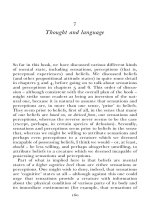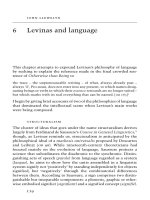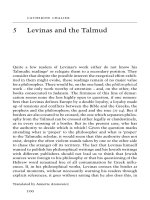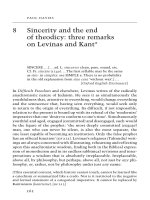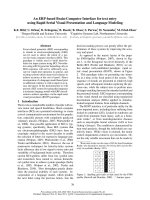Levinas and language
Bạn đang xem bản rút gọn của tài liệu. Xem và tải ngay bản đầy đủ của tài liệu tại đây (162.65 KB, 20 trang )
john llewelyn
6 Levinas and language
This chapter attempts to expound Levinas’s philosophy of language
by seeking to explain the reference made in the final crowded sen-
tence of Otherwise than Being to
the trace – the unpronouncable writing – of what, always already past –
always ‘il’, Pro-noun, does not enter into any present, to which names desig-
nating beings or verbs in which their essence resounds are no longer suited –
but which marks with its seal everything that can
be named. [
ob
185]
1
I begin by giving brief accounts
of two of the philosophies of language
that dominated the intellectual scene when Levinas’s main works
were being composed.
structuralism
The cluster of ideas that goes under the name structuralism derives
largely from Ferdinand de Saussure’s Course in General Linguistics,
2
though, as Levinas reminds us, structuralism is anticipated by the
philosophical ideal of a mathesis universalis proposed by Descartes
and Leibniz (
ob
96). While nineteenth-century theoreticians had
focused mainly on the evolution of language, Saussure projects a
science that subordinates the diachronic to the synchronic. Distin-
guishing acts of speech (parole) from language regarded as a system
(langue), he aims to show how the units assembled in a linguistic
system signify not ‘positively’ by standing independently for objects
signified, but ‘negatively’ through the combinatorial differences
between them. According to Saussure, a sign comprises two distin-
guishable but inseparable components: a phonetic, graphic or other-
wise embodied signifier (signifiant) and a signified concept (signifi
´
e).
119
120 the cambridge companion to levinas
He lays down a programme for a general science of signs, a semiology
of all systems of signs that extends to other special fields the lessons
of the science of language. In this programme relatively simple signs
are identified by the places they can and cannot fill, as in chess what
matters is the moves that can be made with the pieces, not their
shapes or the material of which they are made.
Levinas takes over from structuralism the word signifiant. How-
ever, prising it away from the signifi
´
e understood as the conceptual
aspect of signs, he applies it to the speaker, but to the speaker not
regarded only third-personally or as one of a first person plural we.
For Levinas the signifiant is primarily the speaker in the first person
singular subjectivity of its me, in the accusative case – except that
the word ‘case’ is misleading. Before being a case, the speaker is a face,
the face that speaks. And what the face primarily says, its signifi
´
e,
is nothing but its saying. When I say something there will normally
be some semantic signification of a message, but such sense-giving
Sinngebung is already signifiance, where my saying is my saying of
my saying. Hence, while on the structuralist theory the positivity
of the signs we use depends upon negativity defined by differences
between the constituents of the systematic interdependent totalities
of signifiants and of signifi
´
es, signifiance as what I shall call ‘deep’
saying testifies to the positivity of my being accosted by another
human being, an event that holds ‘the secret of the birth (naissance)
of thought itself and of the verbal proposition by which it is con-
veyed’ (
cp
125). Signifiance is without horizon or world. Although or
because it is the expression of the face of my neighbour, it infinitely
transcends the confines of culture; so its saying is prior to every his-
torical language (
cp
122). Other
than the countenance, the face has
no features or properties or substance, no ousia. The signifiance of
the face is abstract, but its abstractness is prior to the abstractness
defined by the structuralist as the separability of the intersubsti-
tutability of propositional signs from a given empirical embodiment.
Precisely because in structuralist semiotics the components or
terms owe their meaning to their internal interrelations, it is ar-
guable that there is only one unit, the system as a whole. This sug-
gests an analogy with mathematical systems, where it is arguable
that the mathematician reads off from the system as a whole the the-
orems he calculates or infers. One might say that it is the system that
thinks through the mathematician. And something like this is what
Levinas and language 121
is said by some of the human scientists who apply Saussure’s model
to their own special fields. With some structuralists the idea that
‘it’ (es, c¸a) thinks in me turns into the idea of ‘the death of man’,
so that it becomes questionable whether they can properly be called
‘human’ scientists. Lacan in psychoanalysis, Althusser in political
theory, L
´
evi-Strauss in anthropology and Foucault in the genealogies
of knowledge and power are among those whom Levinas would see as
representatives of ‘modern antihumanism’ (
ob
127). Although this is
a description many structuralists embrace,
they do so, Levinas main-
tains, only because they identify humanism with the idea that the
human being is
first and foremost the author of his acts, including
his acts of speech. Kantianism is typical of humanism understood
in this way. Spontaneity and freedom are stressed, too, by the exis-
tentialism against which structuralism reacts. One of Sartre’s titles
declares that existentialism is a humanism.
3
For him, as for Kant
and for the tradition culminating in them both, humanism is a hu-
manism of the first person singular subject.
ontologism
According to Levinas, much the same holds when one turns from
the humanism of the subject to a humanism of a being whose way
of being is that of being placed, being somewhere, here or there:
Da-sein. Da-sein, Heidegger maintains in Being and Time, is in each
case mine (jemeinig). Da-sein is mine-ish. Da-sein is a being that
interprets itself and its place (Da) in its world. Its way of being is
for its being to be in question. It is therefore with a questioning of
questioning that the analysis of Da-sein begins. Heidegger enumer-
ates the elements of investigative questioning – Untersuchung,asin
the German title of the Logical Investigations of Husserl, the dedica-
tee of Being and Time. These components include the topic, which
in the case of Heidegger’s bookis Being; what we seekto discover
about the topic, which in this case is the meaning of Being;
and that
at which attention must be directed in order to discover this, here
the beings in which Being resides. The being pre-eminently to be
addressed, Heidegger maintains, is precisely the being that is able
to raise the question of the meaning of Being, the so-called ‘human
being’ or Da-sein. Heidegger also maintains that the question of the
meaning of being is first and foremost the question each Da-sein
122 the cambridge companion to levinas
puts to itself about its own being. To state this in the terminology
of Being and Time, ontological and existential questioning begins
in questioning that is ontic and existentiell. It will turn out to be
of importance for our understanding of Levinas’s teaching that in
Heidegger’s analysis the being to whom is put the existentiell lead-
ing question is none other than the person by whom that question is
put. For Heidegger questioning is first self-questioning: not initially
fragen, but sich fragen, Da-sein’s ability to askitself about its own
way of being toward its own death.
linguistic possessions
In the ‘Letter on “Humanism”’ Heidegger calls language the house
of Being.
4
Taking the liberty of reading Being and Time in the light
of this later remark, but appealing also to Heidegger’s demonstra-
tion in the earlier workitself that Da-sein’s being in the world is its
being in language or discourse (Rede), could one say that while the
point of entry into Heidegger’s account of language in Being and
Time is the question and questionability, the point of entry into
Levinas’s account of language is the response and responsibility?
This would be to oversimplify. For a notion and sense of respon-
sibility (Antwortlichkeit) is all pervasive in Being and Time.
But the responsibility that figures in that bookand in Heidegger’s
later works is finally the responsibility towards Being, whereas the
responsibility that is first and last in Levinas’s treatment of language
is responsibility to the other human being. And in so far as the target
of his ‘humanism of the other man’ is the ‘anti-humanism’ he sees
in theories like structuralism, it cannot fail to have in its sights at
the same time the accounts of language put forth by Heidegger in
the course of which we are told both that Da-sein has language and
that Da-sein is, as we might say, had by language.
5
Language is not
merely a competence possessed by a subclass of animals, the ratio-
nal
ones, the
z
ˆ
oon
logon echon
of Aristotle. Da-sein is and
has in its
essence to be the place (the Da) where language speaks. There is then
a mutual belonging of Da-sein and language, as is indicated formally
by the conjunction of the name Da-sein with the statement that lan-
guage is the house of Being and with the idea that Da-sein has to be
(zu sein hat), to take on, to assume the responsibility for the that and
the how of its Being.
6
Language on this account is not ultimately to
Levinas and language 123
be compared, as Wittgenstein compares it, with a toolbox.
7
We speak
English or German or French, but that is because we already belong
to the linguisticality of which the speaking of natural languages is
a manifestation. Language speaks, ‘die Sprache spricht’.
8
Although
it is not incorrect to say that we possess this or that language and
the ability to speakit, prior to that is our being possessed by lan-
guage.
Prior to my being possessed by language, Levinas maintains, is my
possession by the human being who speaks to me. But, again, this
formulation of the difference between Levinas’s and Heidegger’s doc-
trines of language is too simple unless we acknowledge the difference
between what each of them means by possession and recognize that
the difference between Heidegger’s and Levinas’s doctrines of lan-
guage is not merely a difference between monologue and dialogue.
Already in Being and Time Da-sein’s being possessed by language,
understood as a basic structure of Da-sein’s occupying a place in the
world, is a way of Da-sein’s being with others, mit-Da-sein. Being
in the world is Being in dialogue. Sprache is Gespr
¨
ach. Heidegger
can say this despite his saying that language is monologue,
9
for
what he means when he says that language is monologue is that
although it is language alone (allein) that speaks authentically and
although this speaking is lonesome (einsam), lonesomeness is pos-
sible only if one is not alone, not solitary, not cut off from com-
munity. Lonesomeness is a way of not being alone; it is a privative
way of being with others. Therefore our earlier reference to the self-
reference of Da-sein’s questioning must not be taken to imply that
the mine-ishness of each Da-sein is incompatible with an original
sociality.
However, there is more than one way of understanding this so-
ciality. For both Heidegger and Levinas it is linguistic, and a way of
being possessed by language. But, to repeat, whereas for Heidegger
possession by language is a way of being with others, for Levinas
it is also a possession by others. This latter possession disrupts my
being possessed by language as this is understood by Heidegger. My
possession by language is obsession at the same time – or rather
from a time beyond recall of which the diachrony is anterior to the
diachrony correlatively opposed to synchrony by the structuralist.
The other’s call to responsibility to her or to him and to the third
party, that is to say, to the whole of humanity, is anterior to the call
124 the cambridge companion to levinas
to responsibility to being. Its anteriority is announced in a pluper-
fect tense marking the diachrony of a time incommensurable with
what a verb in the present tense might have reported. This ab-solute,
separated past is contained neither by the structuralist’s idea of lan-
guage as a synchronous totality nor by the Heideggerian ontologist’s
description of a historical (geschichtlich) dispensation (Geschick)as
a unitary whole in which Da-sein’s having-been, coming-toward and
making-present are co-implicated.
Combining Heidegger’s turn of phrase with one of Levinas’s, we
can say that the human other breaks into the house of Being like a
thief (
ob
13). This possession by the
other is a dispossession of my
home and my belongings, a discomforting that is, to use Heidegger’s
word, un-heimlich, unhomely. I am disconcerted, discountenanced
and decentred. Prior to the subject’s self-consciousness, prior to the
mine-ishness of the self that says ‘I’, and prior to all consciousness,
the self is the me accused by some other human being whose place in
the sun I have always already usurped simply by being here, simply
as ego or Da-sein. Levinas goes as far as to call this obsessive pos-
session by the other psychosis, intending us to hear in this reso-
nances both of Husserl’s Beseelung, animation, and of madness or
folly, the topic taken up from Freud in the work of Foucault and
Lacan.
Another of Levinas’s contemporaries who should be mentioned in
this context is Ricœur. No less critical of structuralism than Levinas,
holding, like him (and John Austin),
10
that the study of language as
an object of science must be supplemented by reflection upon mo-
mentary acts of speech, Ricœur makes a special analysis of avowals.
But this analysis, like psychoanalysis, is conducted within the frame-
workof the symbols and primarily Greekmyths where the notions
of impurity and culpability arise in the West. So the concern with
parole that Ricœur shares with Levinas is of a sort that leads him to
stress the importance of narrative even in his investigation of con-
fessions of guilt. Typically, the confession of guilt isolates the person
who confesses. In owning up I come to own myself, even if the guilt is
shared.
11
On Ricœur’s account the isolation effected in the acknowl-
edgement of culpability is not itself isolated from the context of a
narrative or myth. It therefore serves well to bring out the boldness
of Levinas’s account. For, according to the latter, culpability is inde-
pendent of such narrative or mythological contexts, notwithstanding
Levinas and language 125
that Levinas sometimes cites even in his more philosophical writings
stories from the Hebrew Bible by way of illustration.
nouns, verbs and verbal nouns
A narrative is a sequence of statements. Among the simplest state-
ments, at least in Indo-European languages, are predicative ones in
which something is said about something or somebody. The subject
about which the statement says something is represented in the sen-
tence by a noun or noun-like term. What is said about it is expressed
in a phrase involving either the verb ‘to be’ explicitly or a short-form
verb, e.g. ‘runs’, paraphrasable by a long-form copulative expression,
e.g. ‘is running’. Taking the hint from languages like German, where
‘Das Himmel blaut’ says ‘The sky is blue’, some logicians, for in-
stance Quine, have pointed out that long forms can generally be
transposed into short forms, as in ‘The President of the United States
clintonizes’, ‘The teacher of Plato socratizes’, ‘Pegasus pegasizes’.
12
Following what he takes to be Heidegger’s teaching on the verb and
verbal noun (
ob
189), Levinas gives as examples of identity state-
ments ‘Socrates socratizes’ and ‘Red reds’. Another example given
by him orally, but not to my knowledge in print, is ‘Le violoncelle
violoncellise’. These express, he says, the fashion (fac¸on) in which,
for example, Socrates is (
ob
41). He italicizes this word in order to
bring to our attention that it derives from the Latin facere,todoorto
make, and in order to help us to hear in predication the time, tense
and verbality of being and the adverbiality of being’s modalities, its
Seinsweisen. But here Levinas’s word for ‘being’ is ‘essence’. In a note
at the outset of Otherwise than Being he explains that he does not
use the word ‘essence’ as it is traditionally used, for the nature or
whatness of something. He uses it in the verbal sense in which Sein
is used in German and in Being and Time in opposition to Seiendes,
this latter standing for a being, an
´
etant. Nevertheless, the second
syllable of
´
etant retains a trace of the suffix ance from which ab-
stract nouns of action are formed through derivation from antia and
entia, for example naissance, a word we earlier found him using in
the course of explaining this point, and signifiance, a word to which
we shall return below. Other examples are tendance, a word used in
Otherwise than Being in conjunction with a family of words based
on tendere, e.g. ostension, and essance. This last is a word Levinas
126 the cambridge companion to levinas
says he will not be so bold as to use there, notwithstanding that it
would have represented well the verb-noun ambiguity of Sein and
Wesen and the fact that
ˆ
etre can be either a verb or a noun.
The hidden difference at issue here is what Heidegger calls the on-
tological difference, the difference between Being and a being present
already in the ambiguity of the Greekword on. Levinas calls this
difference an amphibology. Because there survives in the second syl-
lable of
´
etant a hint of the action and verbal-cum-adverbial fashion
exemplifed in ‘Socrates socratizes’ Levinas might have had no objec-
tion to translating this into ‘Socratizing socratizes’, by analogy with
Borges’s Heraclitean verbalizing conversion of ‘The moon rose above
the river’ into ‘Upward behind the onstreaming it mooned’. But note
in this last example the pronominal ‘it’ that insists on itself as stub-
bornly as it does in ‘It is raining’, ‘It reds’, ‘Es gibt Sein’, and ‘Es gibt
Zeit’. These last two, meaning ‘There is Being’ and ‘There is time’
(literally ‘It gives Being’ and ‘It gives time’) pose what may seem to
be a problem. In his essay ‘Time and Being’ Heidegger says that the
belonging together of these two statements, signalled by the ‘and’ of
his title, is expressed by the word Ereignis.
13
In colloquial German
this word means a happening or event. Now just as one cannot say ei-
ther of Being or time that it is or gibt, nor can this be said of Ereignis.
To say any of these things would be to treat Being as a being, time as
in time and happening as a happening. The best we can do, Heidegger
concludes, is to say ‘Das Ereignis ereignet’. Although Levinas may
have this apparent tautology in mind when he writes ‘Socrates soc-
ratizes’, it should be observed that the latter is a statement about a
being in time. Heidegger’s statement, on the other hand, purports to
be about Being and time, yet, as the definite article Das indicates,
it puts Being in the same logico-grammatical slot as is occupied by
the proper name ‘Socrates’. Heidegger’s statement fails to markthe
ontological difference. Of this he is quite aware. He goes as far as to
argue that the history of philosophy is a history of the forgetting of
this difference by philosophers and of their failure to become aware
of this forgetting. Hence they fail to askhow one can speakof Being
without saying the opposite of what one means or wants to say.
14
Frege raises the question of how one can consistently say either
‘The concept horse is a concept’ or ‘The concept horse is not a
concept’.
15
Appearances to the contrary, the first of these is not an an-
alytical truth, and the second is not a contradiction. Both suffer from
what he calls the ‘awkwardness’ that a concept is what the predicate

